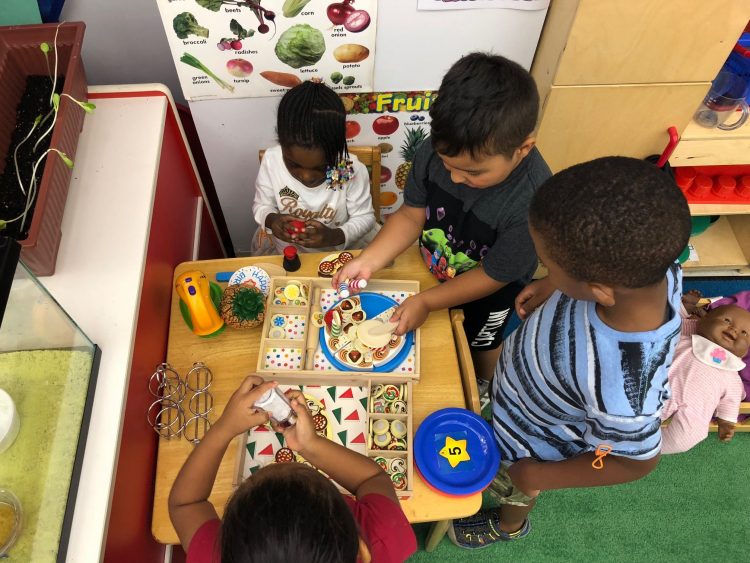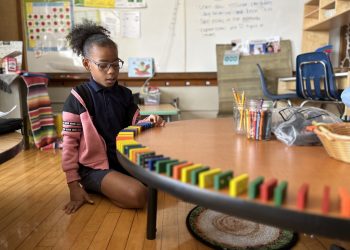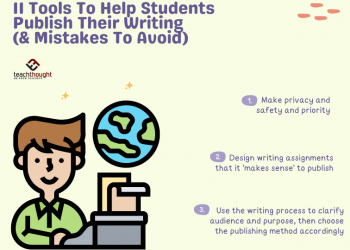Editor’s note: This story led off this week’s Early Childhood newsletter, which is delivered free to subscribers’ inboxes every other Wednesday with trends and top stories about early learning. Subscribe today!
When teachers make an effort to incorporate a student’s home language into the classroom, multilingual children not only benefit academically, but they also feel a stronger sense of identity.
In a new study published this summer, pre-K educators in New York City saw clear benefits to students speaking multiple languages but found that more professional development and support was needed to fully embrace those languages and cultures in the classroom.
The study looked at 50 pre-K centers in NYC during the 2017-18 and 2018-19 school years to see how early educators taught multilingual learners, which includes children who are learning English. At age 3 and 4, many pre-K students learn to speak a new language on top of a home language they are still learning. The study included students who speak more than two languages.
Overall, the researchers identified four weaknesses in these pre-K classrooms that could be improved to better support students learning multiple languages:
The researchers had a list of recommendations for centers, but one idea arose repeatedly throughout the study: Teachers and leadership need professional development to allow them to continuously improve their strategies for multilingual students.
Educators agreed that there were gaps in their understanding. In a survey conducted as part of the research, they expressed an “urgent desire” for more training to help them teach multilingual children.
“Teachers who have a lot of multilingual learners in the classroom must be feeling overwhelmed as well,” said Chun Zhang, a co-author of the study and professor of education at Fordham University. “If leaders and teachers can develop a system that can gather the information about the children, and about the families they work with, then they can be using that data to build resources.”
Something as simple as including bilingual books in the classroom can make it feel like a more welcoming place for families and students who speak the language, Zhang said.
“You are messaging to the families that their languages are important,” Zhang said, but added that it’s hard for pre-K teachers to know the background and cultural information about young students and their families if the schools aren’t gathering that data.
“I don’t think we have a system that is actually there for teachers and for parents. Every teacher is having this reality, which is they have kids who speak multiple languages at home, but then our system has never been designed to really support those kids,” she said.
There’s an increasing need for this type of support for young learners. The most recent available federal data show that more than 5 million students in the United States were learning English as a second language, a number that is growing each year. In New York, multilingual learners made up 28 percent of the state’s pre-K population in 2017, when researchers at Fordham University started conducting the study on pre-K classrooms.
About 40 percent of students in the average classroom were multilingual learners. The students’ most common home language was Spanish. In all, researchers observed a total of at least 31 different home languages.
“In some situations, there could be 13 languages represented in one classroom,” Zhang said.
The teachers understood the importance of classroom diversity and saw the benefits of students being bilingual, said Tiedan Huang, an assistant professor of educational leadership at Fordham University, who co-authored the study.
“They all feel very positive about the language diversity,” Huang said. “They also embraced the advantage and long-term benefits of multilingualism, but in their practice, they just didn’t incorporate that.”
The study rated the classrooms based on their performance in six areas: gathering background information on multilingual learners, cultural inclusion and integration, curriculum materials, supports for English language acquisition, supports for home language, and assessment. Collectively, the classrooms did not receive a “good” or “strong” score in any of the six categories, but the lowest rating received was in supporting students’ home languages.
Because language plays an integral and important role in students’ lives, it’s important to look for ways to encourage and support that culture in the classroom, the researchers said.
“[It’s] acknowledging each child’s self-esteem, their own language and culture that is really part of who they are,” said Zhang. “If educators and policymakers do not really appreciate the bilingualism, the multilingualism, and the connection to identity, I think we could be creating the loss of home language, and eventually, the loss of identity and mental health issues in the long run.”
This story about multilingual students was produced by The Hechinger Report, a nonprofit, independent news organization focused on inequality and innovation in education. Sign up for the Hechinger newsletter.
Related articles
The Hechinger Report provides in-depth, fact-based, unbiased reporting on education that is free to all readers. But that doesn’t mean it’s free to produce. Our work keeps educators and the public informed about pressing issues at schools and on campuses throughout the country. We tell the whole story, even when the details are inconvenient. Help us keep doing that.
Source by hechingerreport.org










